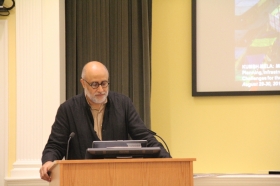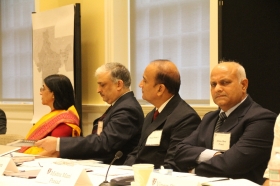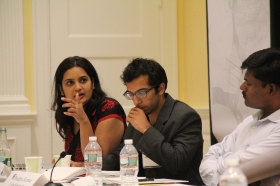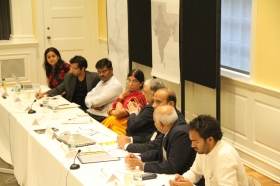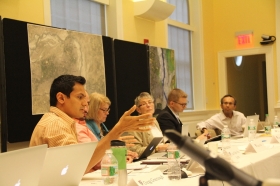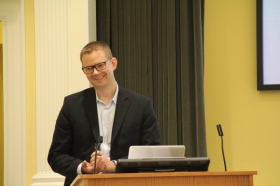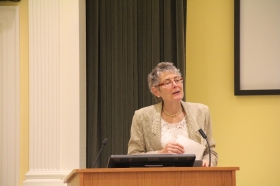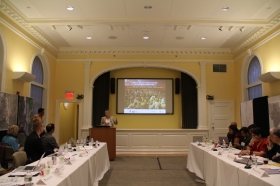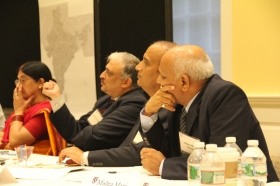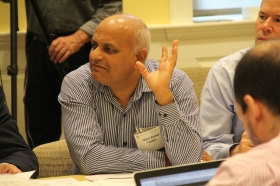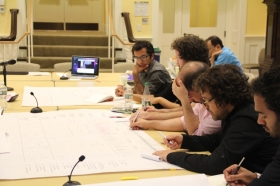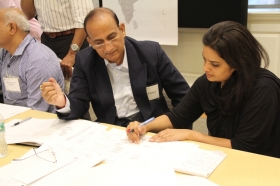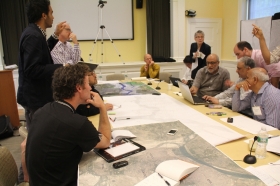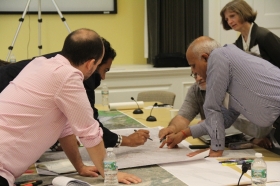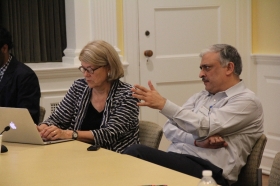Updates from the Radcliffe University Workshop on August 29 and 30, 2013
By Lisa Chase, Research Associate, Harvard Business School & Harvard Graduate School of Design
The spirit of collaboration and community that made this year’s Kumbh Mela festival so successful was on vivid display at the Kumbh Mela: Mapping the Ephemeral City workshop August 29 and 30 at Harvard University’s Radcliffe Institute for Advanced Study. This gathering of government officials from the Indian state of Uttar Pradesh responsible for planning and managing the Kumbh Mela, faculty and students from FXB Center for Health and Human Rights, Harvard Divinity School (HDS), Faculty of Arts and Sciences (FAS), Harvard University Graduate School of Design (GSD) and School of Public Health (HSPH) ; Harvard Business School (HBS); the Harvard South Asia Institute (SAI) and Harvard Global Health Institute (HGHI), epitomized the spirit of interdisciplinary collaboration and academic curiosity that inspired the HGHI and SAI to sponsor the workshop. Representatives from Uttar Pradesh included Higher Education Secretary Devesh Chaturvedi, Professor and Head of the Department of Community Education Shraddha Dwivedi, Mani Prasad Mishra, District Magistrate and Mela Chief Officer, and Deputy Inspector General of Police Rajesh Rathore. Mela Inspector General, Alok Sharma, joined the team from India via Skype.
The Kumbh Mela workshop commenced with a discussion, led by Professor Diana Eck, HDS, FAS, on the governance and religious aspects of the festival, including the inclusive nature of the event, which included ethnic and religious groups from across India, Asia, Europe and beyond. Professor Eck invited the administrators responsible for planning and executing the Kumbh Mela to contribute their insights into the intricate process of accommodating more than 32 Hindu sects, “tourists” of various faiths drawn to the festival, and the political considerations of allocating space for and catering to the unique needs of influential religious groups, including the Akharas. The workshop progressed to the practicalities of acquiring almost two thousand hectares of land from the Indian military, farmers and the railway department to accommodate the approximately 80-100 million pilgrims over the course of the 55 day festival. GSD Professor Rahul Mehrotra and Uttar Pradesh officials explored the considerations of apportioning parcels for the diverse array of Kumbh Mela pilgrims, including fielding and screening applications to determine the credibility of their spiritual – as opposed to speculative real estate – interests, assigning parcels with an eye to their proximity to the primary bathing areas, while encouraging connections between geographic regions, ethnic and religious groups.
Following lunch, HBS Senior Lecturer John Macomber led a discussion on the infrastructure implications, including the environmental impacts, of the Kumbh Mela. Macomber queried the administrators about the process of laying out the roadways, electrical, sewage and water infrastructure over the grid of the Kumbh Mela landscape. The exchange revealed the complexities of designing and constructing a temporary settlement that draws on a legacy of British urban planning and accommodates the variable environment imposed by shifting water levels and dry land, with the Central and State governments taking responsibility for the macro level infrastructure and leaving the details “inside the tent” to private sector and civil society organizations. A discussion of organizational structure and economy was led by Director of SAI and HBS Professor Tarun Khanna and Assistant Professor J.P. Onnela of the HSPH, focused on their cell phone data study of mobile phone text and voice messages from the Kumbh Mela, and the relationship of these communications to human social behavior. The applications of the data, and what it reveals about human communication patterns and networks, are myriad, including enabling epidemiologists to study disease vectors in new ways, planners to design transportation improvements, and environmentalists to examine human impacts. HSPH Professor Jennifer Leaning and Research Fellow Satchit Balsari closed out the day’s panel discussions with an examination of the numerous public health considerations, including ensuring access to safe drinking water and toilet facilities, providing healthcare and hospital services, planning crowd control and security, and protecting against the spread of infectious diseases. Professor Leaning highlighted the success of the health clinics and public health infrastructure in caring for the Kumbh Mela pilgrims, and the lessons the administrators and government officials may apply to healthcare delivery for the general population outside of the festival.
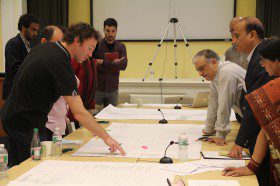
The workshop’s second day focused on spatializing and mapping both the planning and construction processes of the Kumbh Mela and the deconstruction and “disposal” phases of the event. Under the Kumbh Mela administrators’ direction and led by Felipe Vera from the GSD, faculty and students laid out every facet of the infrastructure planning, design and construction, along with management and governance functions, on physical site plans and drawings constructed by the GSD students. Mapping included documenting the sequence of architecting the land’s grid layout, planning roadways and transportation, engineering electrical delivery and water access, and framing the chain of governance and oversight. The mapping exercise underscored the administrators’ deliberate and detailed approach to framing every facet of the Kumbh Mela, guided by the primary goal of ensuring a safe and satisfactory spiritual experience for every pilgrim, regardless of religion or ethnicity. Following the mapping activity, Namita Dharia, a Ph.D. candidate in Harvard’s Department of Anthropology, framed a discussion about the almost monumental task of deconstructing the Kumbh Mela’s temporary city, including reclaiming and reusing construction materials, taking down electrical and lighting systems, removing sanitation systems and toilets, and dismantling temporary bridges and girders. The deconstruction process was rendered more complex because of the various agencies and officials responsible for respective infrastructure components, including private contractors and a diverse range of employees and volunteer labor.
During the workshop’s concluding discussions, Harvard faculty invited the Kumbh Mela administrators to share anecdotes and “lessons learned” from the festival’s planning, execution and deconstruction. Perhaps one of the most striking takeaways was the success of the central and state governments’ public service campaign urging pilgrims to follow safe hygiene, sanitation and security practices, including environmental conservation and protection. The effectiveness of the public relations scheme was evidenced by the absence of any major communicable or water-borne illnesses at the Kumbh Mela, while environmental damage from plastic trash and water pollution was significantly reduced from previous festivals. At the workshop’s close, Harvard faculty and Uttar Pradesh administrators discussed the potential for a continuing collaboration between Harvard faculty and Kumbh Mela administrators. The partnership would enable Harvard faculty and researchers to continue studying and learning from Uttar Pradesh officials and their festival management, while potentially advising administrators on how to refine aspects of the Kumbh Mela and associated religious celebrations and extrapolate their infrastructure planning to the wider Indian population. As Diana Eck described it, the Kumbh Mela process is never finished, but continues as an iconic story of spirituality and community, of which Harvard University hopes to be an ongoing participant.



